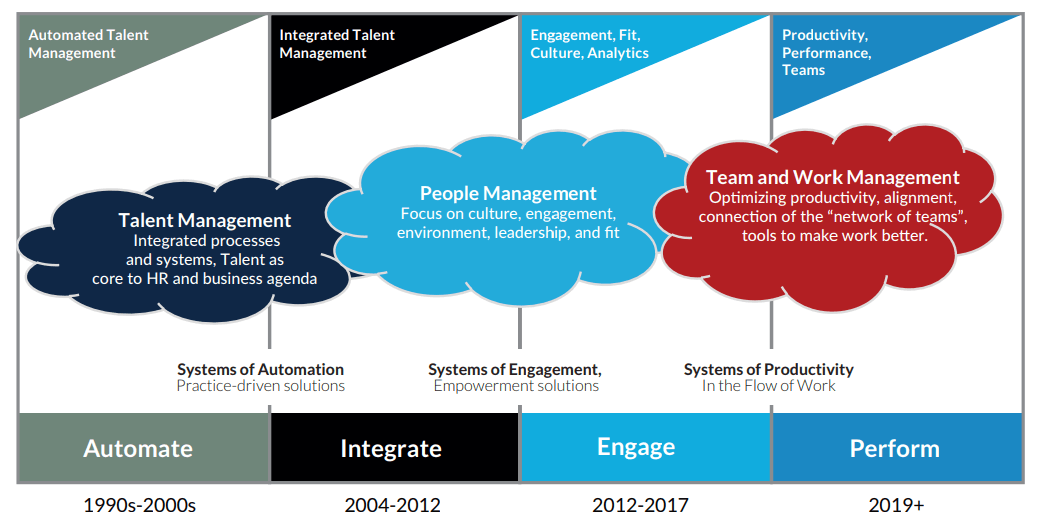5 Frontline Pain Points for 2023 and How to Solve Them
2020 Talent Development Systems Transformed
Today, all proactive companies are massively upgrading, optimizing, or completely replacing their current HR and performance improvement tools. According to Josh Bersin, more than $2 billion was invested in the talent development market this year to keep pace with changes in the business world and the consumerization of workforce experience.
However, with heavy investments come heavy demands. Companies are now looking for more than just a talent development system, performance management or HR tools. Companies want a solution that is as agile as the business world to keep pace with the future of work.
Key reasons why companies look for new HR tools

Every tool comes from the need to optimize one of the many work processes. More than a decade ago, there were many fragmented systems aimed at serving one need at a time, be it workforce engagement, performance management, learning and development, or communication and collaboration.
With time, more and more tools flooded the corporate training market, offering an unimaginable amount of software. Even for the nearest future, they predict the market to grow at a CAGR of 9.06% by 2022. This only aggravated the situation. The problem is that countless applications don’t entail the efficiency or improvement of positive user experience due to their autonomies.
Training leaders are fed up
“We’ve more or less reached the stage where L&D executives are fed up,” writes Josh Bersin, describing the current situation on the market. Yes, vendors with their best-in-class fragmented solutions have gone too far. Training leaders don’t want to get solutions for parts and pieces of challenges. They want a robust machine – a system that would address all the challenges related to workforce management and development right away.
As Josh points out, big companies, of course, can have senior learning architects who “sort out tools, test them, and bring them together into a solution.” Yet, few can afford to have a special professional for this task. The majority of executives look for integrated workforce development & management solutions.
Workforces are overloaded
In the era of digital transformation, it has become a tradition to have as many “work-optimizing” tools as possible. But does it bring benefits? Imagine a world where every simple activity requires you to take a lot of steps. For example, you might want to send a happy birthday text message to a friend. For this, you’ll need an app where you can store all of your contacts. Then, you’ll need an app that would allow you to search for a specific contact via a search bar instead of scrolling through a long list. Next, you’ll need a separate app that would make it possible to attach photos, another app to attach videos, gifs, files, etc., and one more app for emojis. Well, you get the idea. A simple action would take so much time, efforts, and tools. Are you ready to sacrifice them?
The same principle goes for workflow. It’s all about optimization and facilitation. Fragmented tools not only waste precious time and, as a result, money, but also make people feel like quitting or getting frustrated.
The conclusion: get a system that will keep all your needs in one place.
Yes, today we need more and more tools to stand out and succeed, but at the same time, we need these complex tools to be user-friendly and cohesive with corporate brand and culture.
The problem is that not all vendors are ready to adapt to these needs.
Productivity systems are the result of the evolution of HR tools
Let’s think of the first reason why companies leverage all these engagement tools, collaboration apps, learning and performance management systems, etc. It all comes down to productivity.
High productivity means high profits. Also, high productivity means happy people, people who know that their contributions are making an impact. That’s why companies have been focusing on engagement, culture, work-life balance, learning and development, and incentives, among other aspects, for so many years. Since productivity is such a complex notion that includes an array of aspects to take care of, there must be a complex but easy-to-use, flexible solution containing all the necessary tools for success.
Josh Bersin calls this solution the systems of productivity.
Integrated platforms are arriving: a move from what I call “horizontal” to “vertical” or integrated platforms. By “vertical” I mean the vendor has decided to put together a “stack” of solutions that address all parts of your learning needs, as opposed to a “horizontal” solution where they sell their slice of the problem to many different customers. It’s like selling “car radios” vs. “cars.”
Josh maps out an evolution that highlights the way the focus of companies has changed with time as well as how vendors approach addressing these needs.

HR Technology Market 2019: Disruption Ahead by Josh Bersin
The new generation of tools is a productivity hub aimed at facilitating work and optimizing the performance of each individual. These tools not only adapt to new models of work (gig or mobile) and changing needs but also create a consumer-style workforce experience from top to bottom – improving recruitment, onboarding, learning, performance development, reward system, and other aspects.
Having helped industry-leading companies drive their workforce productivity for seven years, we have built a data-driven performance enablement platform that revolves around every individual’s needs, the goals of a company, and workflow optimization. The platform is deeply integrated into all existing systems (HR, CRM, ERP, and others), acting as a common connection point for all organization members. This provides a unified experience that allows every individual to learn, work, and communicate, all in one place.
By helping our customers arrange all the existing tools and power them up with a performance enablement solution, companies enjoy an integrated system of productivity, a single platform that guides every team member to success.
If you want to implement an integrated productivity growth system, feel free to hop on a call with the Rallyware experts!
News and Insights on Workforce Training & Engagement
We’re among top-notch eLearning and business engagement platforms recognized for effective training and talent development, helping to empower distributed workforces
Subscribe
